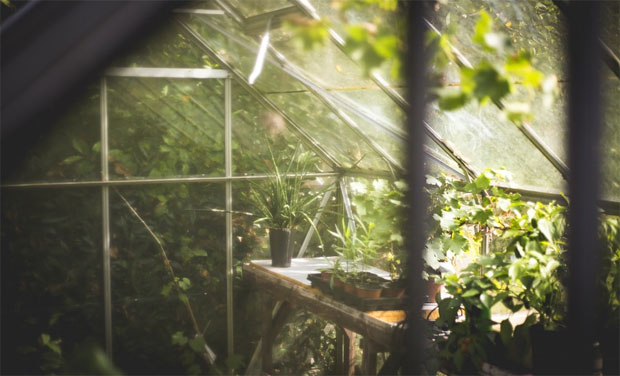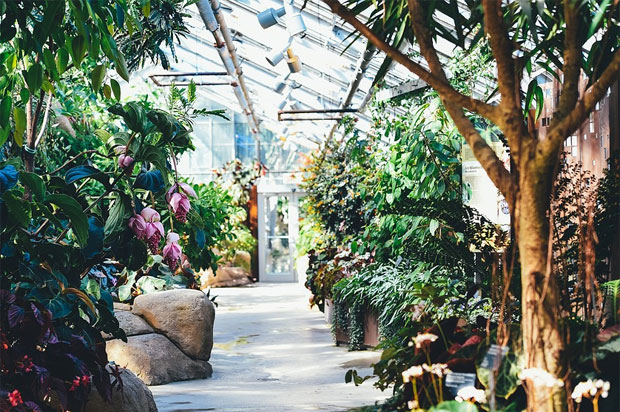Plastic vs Glass Greenhouses – Which Should You Choose?

Plastic vs Glass Greenhouses – Which Should You Choose?
Greenhouses are perfect garden furniture as they allow you to make the most of the seasons, experiment with growing more exotic plants and grow more tender vegetables such as cucumbers, peppers and tomatoes. There are lots of different styles and options for different needs – for example, space-saving lean to greenhouses are a great option for smaller gardens.
As well as choosing the size of your new greenhouse, you need to consider which materials to go for. There are many different glazing options for greenhouses and they all have advantages and disadvantages when you compare them to each other. The correct glazing for your greenhouse will be determined by your personal requirements, preferences, climate and budget.
Together with The Plastic People, who are retailers of polycarbonate sheets, we look at the pros and cons of creating a greenhouse from plastic or glass:
Plastic vs Glass Greenhouses
- How to Fit a Green House
Greenhouses remain in high demand as gardeners are keen to grow their own produce in their home gardens. Customers first face two choices when they decide that they would like a greenhouse – to build one yourself or to buy one that’s ready-built. Buying a ready-built greenhouse can save time and energy but it will cost a lot more so purchasing the parts from a supplier and assembling it yourself could save you hundreds of pounds. It doesn’t actually take as long as you might think, either.
Experts at Gardeners World estimate that building your own greenhouse would only take up one weekend which most of us can put aside for a project like this if gardening is our hobby. There are plenty of tutorials online to guide you into building a greenhouse but it consists of five main steps:
- Ensuring you have a level foundation
- Assemble each section and attach loosely with clips and bolts
- Fitting the door runners, the door and any automatic window openers or vents
- Lining the glazing bars with foam glazing tape or rubber strips to act as a seal. Fit the roof first with glass or polycarbonate sheets and then the wall panes
- Tighten all the bolts, starting from the top of the fixture
If DIY is something you’re not confident in, you can buy a greenhouse from a garden retailer instead.
- Pros & Cons of A Glass Greenhouse
Gardeners who greatly value the aesthetics of their garden tend to go for glass greenhouses as it gives the ‘traditional’ look and they do look nice! Research by gardeners at The Telegraph found that, compared to twin-wall polycarbonate sheets, glass had a 2-3% higher light transmission. The reason for this, is that the light scatters as it passes through the twin-wall and manages to reach areas that light penetrating through glass cannot which could be advantageous.
One negative of glass is its durability. If your greenhouse is in the flight path of any birds or footballs, you could find yourself replacing the panes regularly which could be expensive and quite annoying. Don’t choose glass if you have children or grandchildren that use the garden to play in. Glass is very fragile as a material and can become damaged off a small bump.
- Pros & Cons of A Plastic Greenhouse
There are many advantages of introducing polycarbonate panes to your greenhouse but the main one is that it’s very strong and durable. Some polycarbonate sheets, like the ones sold by The Plastic People, were found to be 200x stronger than glass yet half of its weight. This makes the material easy to use and much more durable. Because of this, polycarbonate does not need replacing as much as glass and has been found to be a longer lasting alternative for traditional glass panes. Upon testing (vigorously with a hammer), the plastic sheets were found to be shatter-resistant which is perfect for any mishaps that may occur in assembly or in the garden.
They also filter out nearly all the harmful UV rays that you may become exposed to when gardening in the greenhouse, allowing you to harvest your crop without the fear of sunburn.
If thermal insulation is important to you and key to the growth of your plants, glass is the slightly favourable option. A single sheet of polycarbonate has 0.1 less ‘R’ value (measurement of thermal insulation) than a sheet of horticultural glass. However, this can be solved with a twin-wall polycarbonate panel which assists with useful light diffusion as mentioned.
If twin-wall polycarbonate is your panel of choice, it must be sealed properly as the flutes within the wall can attract moisture, mould and insects. Proper assembly would prevent this from occurring.
Clouding used to be a problem over time, but new technological advancements have prevented this from occurring and the sheets remain clear all year round meaning they look great.
Plastic vs Glass Greenhouses – Conclusion
The conclusion is that polycarbonate sheets could be the new glass when it comes to greenhouse panes with their boasting durability, shatter resistance and light diffusion in all the right places. They’re perfect for the British weather and any challenges it might bring!
Sources:
- https://www.rhs.org.uk/advice/profile?PID=613
- http://www.gardenersworld.com/how-to/diy/how-to-build-a-greenhouse/
- https://www.theplasticpeople.co.uk/products/uses/greenhouse-glazing/
- http://www.wintergardenz.co.nz/glass-vs-poly-vs-film.html
Collaborative Post. Contains a sponsored link.






Interesting read
The jury is still out with me
I love the traditional glass look but as you say they are not durable
I’ll have a good read through the links
Thanks for the info